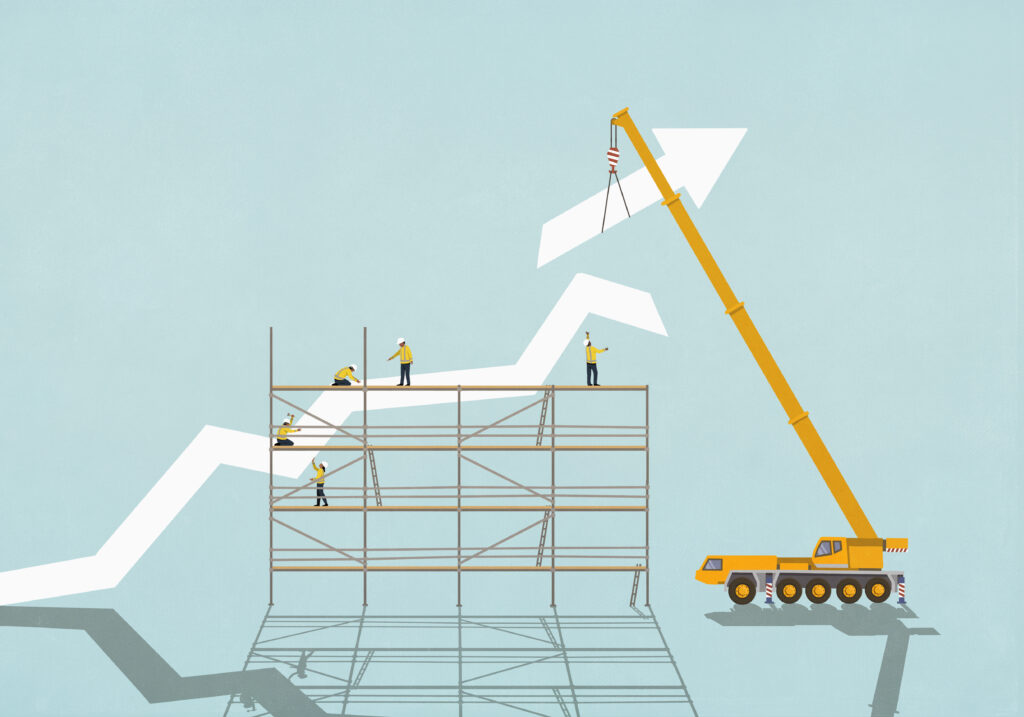
Tremors

The devastating earthquakes in Turkey and Syria earlier this year highlighted the importance of evaluating earthquake risk, mitigating risk factors and acting on response preparedness.
According to the Aon Global Catastrophe Recap, the first half of 2023 saw the fifth-highest economic impact from disasters on record and the highest since 2011, largely driven by the earthquakes in Turkey and Syria. The report preliminarily estimated global natural disaster losses at $194 billion, with the earthquakes in Turkey and Syria responsible for nearly half the total.
In the first half of 2023, the earthquakes in Turkey and Syria accounted for nearly half the natural disaster losses worldwide.
In California, there remains very real seismic risk for which residents and business owners should be prepared.
According to one national institute, modern building codes save $11 in disaster repair and recovery for every $1 invested in new-code construction.
While the report notes there are several estimates of economic loss for the Turkey and Syria earthquake, it lists $91 billion as the current cost, including total physical damage as estimated jointly by the government of Turkey, the World Bank, the United Nations and the European Union.
At the same time, repeated tremors in parts of California have served as a reminder that, even though the state hasn’t seen a major earthquake in decades, there is still very real seismic risk in the state for which residents and business owners should be prepared.
“Despite there not being a major event in almost 30 years, there’s been enough tremors in California to startle a lot of corporates,” says Megan Linkin, Swiss Re’s senior parametric natural catastrophe structurer in North America. Linkin cites the Napa Valley earthquake in 2014, the Ridgecrest earthquake sequence in 2019, and the Eureka earthquake in 2022.
As a result, interest in earthquake coverage has increased. And there are non-traditional products on the market that take into account more than just structural damage to buildings. Many experts agree that a holistic, community-based approach must be used to build resilience against this type of event, one that considers all of the parts of a business’s value chain, not just physical damage.
Building Codes Lack Standardization
Modern building codes provide a baseline of protection against natural hazards and extreme weather events. The U.S. National Institute of Building Science’s Natural Hazard Mitigation Saves estimates that adopting modern building codes saves $11 in disaster repair and recovery for every $1 invested in new code construction.
And while eight out of 10 Americans believe superior building codes protect their homes, only 27% of cities and counties in the United States have adopted the latest natural-hazard-resistant building codes.
“Each devastating earthquake shows the importance of seismic-resistant building codes and practices, but in the U.S., these differ from state to state,” says Kate Stillwell, president of Parametric Insurance. “Brick masonry buildings are particular safety hazards, and in California brick masonry buildings have been outlawed since 1933 after the magnitude 6.4 Long Beach earthquake killed children in a brick school. In most other states, brick buildings remain commonplace.
“In the U.S., earthquakes are not just a California problem,” Stillwell says. “The New Madrid seismic zone could affect Missouri, Illinois, Indiana, Kentucky, Tennessee, Arkansas, and beyond.”
In March 2022, the Federal Emergency Management Agency approved a new building codes strategy to organize and prioritize FEMA activities. The focus is on advancing the adoption and enforcement of hazard-resistant building codes and standards for agency programs. The three goals of the strategy are to integrate building codes and standards across FEMA; strengthen nationwide capability for superior building performance; and drive public action.
“Building codes save lives, time and money,” says Mike Grimm, FEMA’s acting deputy associate administrator for insurance and mitigation. “That’s why FEMA encourages jurisdictions to adopt and remain in line with the current model codes. Buildings designed and constructed to modern building codes developed by the International Code Council withstand the effects of natural hazard events, including flooding, high winds and earthquakes, better than buildings that are not.”
Christine Goulet, a geophysicist at the United States Geological Survey (USGS), says cities and states need to continue to improve building codes and then enforce them during construction. “For example,” Goulet says, “masonry and concrete buildings should be properly reinforced with steel and, ideally, include shear walls. Shear walls are steel-reinforced ‘strong’ walls that prevent the displacement of one floor relative to the other, therefore reducing the stress on support columns.”
Goulet notes that another effective design solution, albeit a bit more expensive one, involves building structures with base isolators at their foundation. Other options include incorporating various damping systems within the structure, designing “damageable” elements to take the brunt of the stress in lieu of the critical supporting columns, or encasing columns with polymer wraps.
Parametric Goes Beyond Property
The economic effects of an earthquake, however, are not limited to the costs associated with deaths and injuries nor to the infrastructure and buildings which are damaged or destroyed. Major earthquakes cause widespread disruption to utilities and supply chains and closures of schools and workplaces.
In southern California, nearly 40% of U.S. imports come through the ports of Long Beach and Los Angeles. A wide range of industries would experience extended disruption, including air travel, agriculture, media and tech. Linkin says that both corporate entities and governments have shown an increased interest in using parametric insurance to offset earthquake risk and that parametric insurance is being offered in several categories of risk.
For example, it’s being used for earthquake exposures that are challenging to insure, such as assets that are difficult to value. “In Latin America a couple years ago, we entered into a policy with an agency that was responsible for maintaining cultural sites,” Linkin says. “You can’t use traditional underwriting methods and risk assessment methods to determine how much it would cost to replace such an asset.
“We have also seen it for financial disruption. Your actual physical assets are hardened against earthquake…but the broad area could potentially be disrupted, and economic productivity could be reduced in the area in which you operate. That could lead to revenue shortfalls.”
Linkin says businesses also use parametric insurance when exploring their reliance on one piece of critical infrastructure. “That could be a port, that could be an airport, it could also be a bridge or a tunnel where, if they rely on that bridge operating or on that tunnel being open or on that airport or that port operating, if that piece of critical infrastructure goes down, their ability to operate their business evaporates or nearly evaporates or they need to invest significant funds to reorganize their business plan.”
The construction business uses parametric coverage in multiple ways, Linkin says. “In some instances,” she says, “they’ve carved out their cat cover. In some instances, they want additional complementary coverage to what they can get in the construction all risk market, and they’ve purchased parametric cover to allow them to get funds very quickly after an event.” Those funds are used in a variety of ways—to replace damaged equipment, say, or to assist workers in getting back on the job.
With all these parametric coverages, Linkin points out, it’s important to note the transparency of the trigger that leads to a payout. For earthquakes, Swiss Re uses either ground shaking at the client locations or the magnitude of the earthquake at its epicenter, data which are reported by the USGS. “Where the earthquake actually releases its energy, if that occurs within a predefined geometry, that could lead to a payout,” Linkin says. “So the key component to our underwriting is location. [You] need to know where your stuff is so we can determine what hazards it’s exposed to and how frequently those hazards would occur.”
Open-Source Knowledge Builds Resilience
Natural disasters are community events, and experts agree that ultimately it is the resilience of the community that determines the amount of loss and suffering. But a growing body of knowledge shows it’s possible to significantly reduce fatalities, injuries and economic losses from disaster damage through open-risk data sharing; the use and promotion of transparent risk assessment tools; adherence to scientific methodologies; inclusiveness and participation; and putting the interest of the public at the fore.
“While there are technical and engineering aspects specific to earthquake resilience,” says Sarah Cumbers, director of evidence and insight at Lloyd’s Register Foundation in London, “many aspects of resilience—at an individual, household, community or societal level—are generic and help protect people in the face of all sorts of natural hazards and other shocks. For instance, household financial resilience, community cohesion, and trust in local and national government institutions all have a role in determining outcomes.”
Cumbers and her team produce the Lloyd’s Register Foundation Resilience Index, which provides a composite measure of resilience based on these factors. Turkey, for example, scores slightly below the global average, ranking 78th of 111 countries included in the index.
“From a company perspective, an important thing to remember is that you are only as resilient as the least resilient part of your value chain,” Cumbers says. “This reinforces the importance of companies’ being conscious of the wide range of factors that will influence the resilience of their employees in the face of a disaster and of being a good neighbor by helping to improve those factors in the communities where they operate.”
Jan Przydatek, director of technologies at Lloyd’s Register Foundation, says earthquakes such as the one that struck Turkey and Syria underscore the importance of investing in resilience—“including the development and enforcement of high safety and engineering standards such as earthquake-resistant building codes.”
To develop and disseminate information about earthquake hazards and risks, and to promote risk reduction and mitigation efforts, the Global Earthquake Model Foundation (GEM) was established in 2009 through the collaborative efforts of global insurers and reinsurers, governments and the risk-engineering community. With the underlying principles of openness, collaboration, public good and credibility, GEM is a public-private partnership created to generate risk information and to build local capacity to conduct risk assessments and to engage with the risk-management community across public and private sectors to reduce risk.
GEM’s flagship products include a global seismic hazard map, a global risk map, and OpenQuake, which is open-source software developed for earthquake hazard and risk modeling. OpenQuake can analyze hazard and risks at a specific site, city, country or regional level.
The recently released seismic hazard model for Europe was computed using the OpenQuake Engine. These results, according to GEM, will “provide the basis for deriving the engineering products for…the subcommittee of national experts that is responsible for the development of Eurocode 8 within the European Committee for Standardization.”
In much of the world, says John Schneider, secretary general of GEM, “seismic hazard and risk assessments either do not exist or, if they exist, are not widely accessible. Local scientists, engineers and practitioners need to have access to the best available tools, models and data to assess risk.”
Schneider, who has a doctorate degree in geophysics, previously served as a member of the UN Office for Disaster Risk Reduction’s Science & Technology Advisory Group. He says scientists and engineers need to be involved in assessing risk “to generate the ownership and trust necessary to promote mitigating actions, such as improvement of building codes and construction practices, sustainable land use, emergency response, and protection of critical infrastructures.
“The catastrophic level of damage to buildings and resulting death toll from the February earthquakes would have been avoided or substantially reduced if an understanding of the risk and the responsibility for addressing it were fully owned by the entire society. The sense of responsibility and ownership starts with the professionals that measure and manage risks.”




